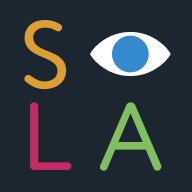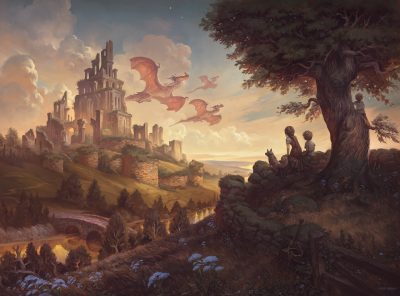 Welcome to our interview series of Illustration West 59 judges.
Welcome to our interview series of Illustration West 59 judges.
Meet Justin Gerard, known for his incredible work in the fantasy genre.
I first became aware of Justin’s work when he was still in college. My two sisters knew him at school, and told me that I had to check out his work. It was clear even then that this talented guy was most definitely going to have an exciting career.
Not long after he graduated, Justin and I became friends, and he came out to California for a visit when I was able to introduce him to San Diego Comic Con. I remember the excitement he had that week meeting lots of artists for the first time that he had long admired. Little did those artists know that they were meeting a young artist that would soon become a leader in their field.
Justin’s work continues to excite and inspire me, as I hope it does for you, too. We are so glad that he is able to take a look at all of this year’s Illustration West submissions. (The deadline is October 31st!) Enjoy this deeper look into the methods and madness of Justin Gerard’s world of monsters and mayhem.
Chad Frye
Illustration West 59 Show Chair
Justin, I’m so glad to have you as a part of this year’s Illustration West jury. I’ve admired your work going back to when you were a college student, and your paintings just keep getting better and better. But there’s something I’m always fascinated by with fellow artists – their beginnings. When did you first think that you might like to be an artist when you grew up? Did you have childhood influences that sparked your imagination?
I had always known that I would be doing art. I was never as centered and happy as when I was drawing. Creating characters and worlds and stories was what I enjoyed the most, and 2D art was the venue that I felt the most comfortable and with. I always knew that it would be a big part of my life, even though as a kid in the ’90s, I didn’t know if it was a real career choice. I am fortunate that I met some freelance artists in college who helped me understand the basics of how to make a career out of it (as long as I could live off of ramen noodles for a couple years while I got my feet under me!).
To look at your body of work, clearly you have gravitated to the world of fantasy illustration. What is it about the fantasy genre that gets your juices going?
I think it is that fantasy art, or imaginative realism, allows us to explore an endless array of possibilities in a way that other art forms may not. Apart from simply being able to share imagery of things that may not exist any more, or that may not exist for some time, it also allows us to see our real world from a new perspective so that we can appreciate just how amazing our world is, and not take things for granted.
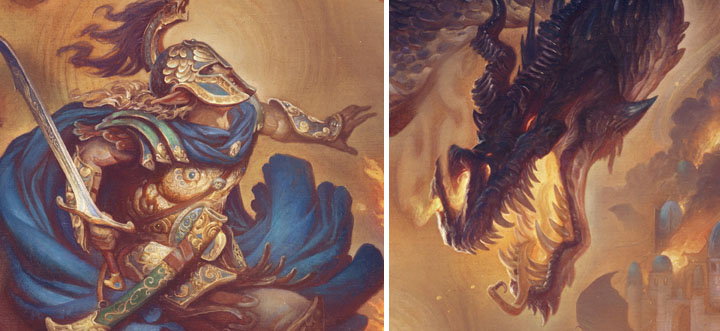
I also love that fantasy art offers interesting ways to personify and express complex emotions. Being able to personify your social anxiety, or your personal struggles as fictitious and imaginary creatures, is an interesting way of expressing to others those feelings.
I think there is nothing wrong with pure representational art, artists do 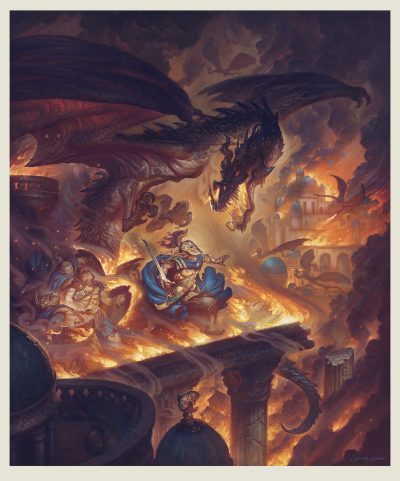 amazing things with it; but for me, I always felt like a camera could just do a better job than I could with it, and because of that, it felt less compelling. Working from imagination, the only bounds are the limits of your own imagination. Fantasy just seems filled with so many wonderful possibilities.
amazing things with it; but for me, I always felt like a camera could just do a better job than I could with it, and because of that, it felt less compelling. Working from imagination, the only bounds are the limits of your own imagination. Fantasy just seems filled with so many wonderful possibilities.
You came on the scene professionally just as digital illustration was becoming a mainstream option for illustrators, and in those early days, you embraced it in a way I had never seen before by combining traditional painting with digital. You create an underpainting traditionally, then fulfill the rest of the illustration with digital tools. Can you expound upon your journey to discover that way of working?
I think it is definitely a product of when I was born. I was born in the ‘80s, and so I grew up in a purely analog world where people still had rotatory phones and even black and white TVs! Record players and cassettes were still a thing. Then by the time I was training to be a professional and enter the work force, the world was transitioning to digital. I was still just young enough to have a foot in the old analog world, but also be captivated by the possibilities of this new digital one. As I moved forward I never quite got out of that place and think I will likely remain stuck somewhere between those two worlds.
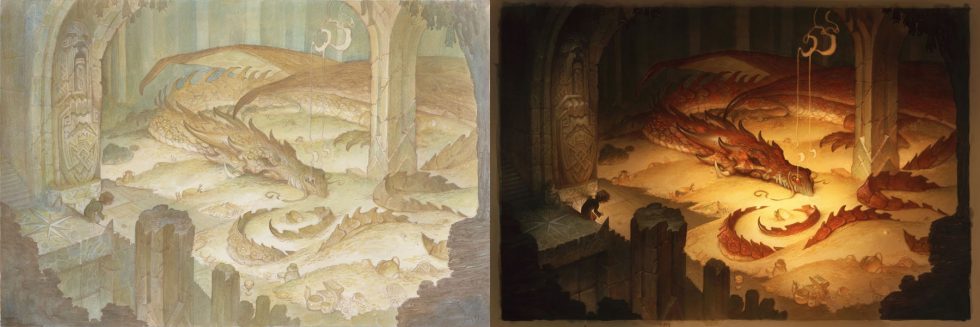
Do you ever allow yourself to create any paintings completely traditionally anymore? Even if just for yourself? And do you ever find yourself habitually reaching for that “undo button” that one gets so used to when working in Photoshop?
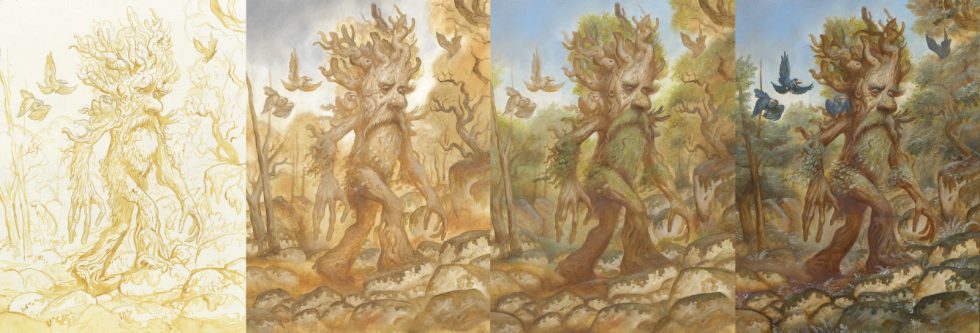

Yes! I LOVE oil, it is in my opinion the very finest of the 2D mediums. I do still paint with it whenever I can, and besides graphite, it is probably my favorite medium for private commission work.
And yes – haha, it is always a bit of an adjustment not having the undo button! But at the same time, I find that a traditional brush is so much more versatile in the kind of strokes and control than what you can achieve with a pen tablet. In oil you can always bend, or blend, or wipe a stroke away if it doesn’t quite look right. I have never felt too hampered without it when working in oil.
The times where I have reflexively wanted an undo button are the disaster moments, where I’ve dripped a spot on my painting and must now wipe away an area and start over, or my cat has knocked my painting face first on the floor. What I wouldn’t give for an undo button then!!
There is a real richness in your work that exhibits a tremendous knowledge of color, and light and shadow. So many illustrators that have come before would take reference photos to help with the accuracy of that. How do you deal with rendering those qualities when so much of your work is of imaginary creatures and places?
 Hmmm…. that is a good question. I don’t know really! I just love the challenge of trying to figure out how the lighting would work in a given circumstance. I also practice at it a lot. I still do a lot of studies from life to help give me that understanding. I think practice helps a lot for having a firm grasp of how light and shadow behave. I also study other artists work a great deal as well… and have found some great tricks and techniques for faking it when you can’t find your way there!
Hmmm…. that is a good question. I don’t know really! I just love the challenge of trying to figure out how the lighting would work in a given circumstance. I also practice at it a lot. I still do a lot of studies from life to help give me that understanding. I think practice helps a lot for having a firm grasp of how light and shadow behave. I also study other artists work a great deal as well… and have found some great tricks and techniques for faking it when you can’t find your way there!
You also do not shy away from generous detail in your work, whether broadly illustrating crowded battle scenes or zeroing in on the tiny skin details of a dragon. Have you ever started a piece and then thought, “What have I gotten myself into?!”
Yes, it happens a lot. Often because there is a part of the illustration I was REALLY interested in, like the figure, and then other parts I was uninterested in, like that skyline in the background. But if you detail the one part, you need to be consistent, and so you’ll have to detail the other part.
Likewise, in the past I have really loved preserving my pencil lines when I go to color, but there are always parts of the image that I think, wow this would look awesome fully rendered and dimensional, but if I make those parts look opaque and finished, then I need to do that with the rest of the image. It is a conundrum that used to bother me a great deal. (Now I just obliterate the lines if I see better opportunities. It makes for more work, but I think the story has to be king, and sometimes you must murder your darlings; or in this case, my precious pencil lines.)
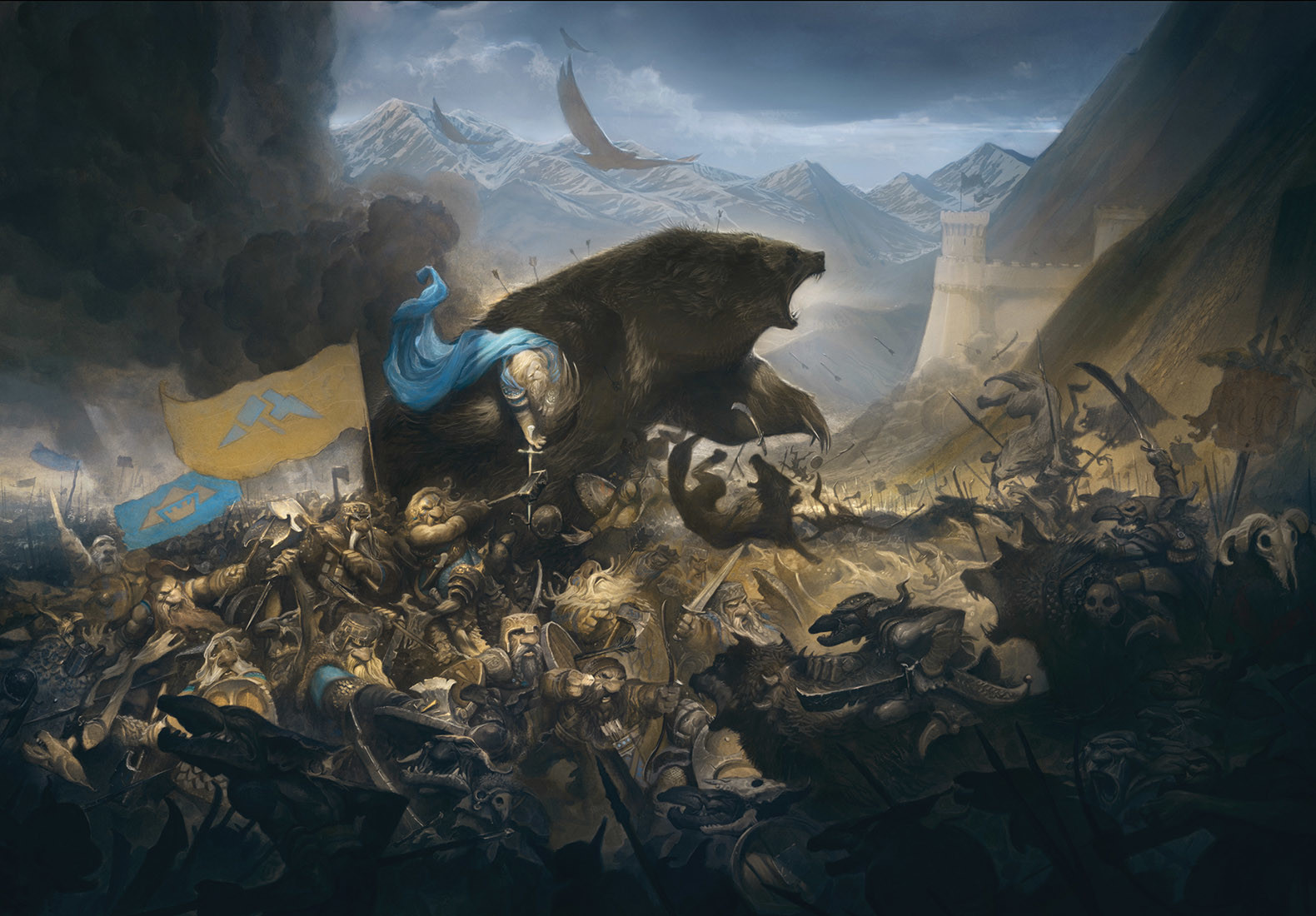
What interesting opportunities have arisen for you from your illustration work?
I have had a lot of interesting opportunities, many of which I simply couldn’t take, and many now that I am still having to turn down. (Some I can’t talk about because of NDAs.) The greatest of all was getting to meet my wife Annie at DragonCon back in 2011 when I was the guest of honor there. If I hadn’t worked in illustration I would never have met her!
Before all that though, I had a chance to work at Blue Sky Studios that was extremely tempting as Peter de Sève was also there, and he has always been an art hero of mine. There was a chance to move to Los Angeles to work on the Hobbit films at Warner Bros. as well. I also had offers from two of the big video game companies that were tempting, but each step of the way I ended up deciding that I wanted to do my own thing from home. I wanted to create my own intellectual properties, books, and imagery for a while. I might come back to work in a company or on a big film in a studio again someday, but right now I am really enjoying just doing my own thing and working from home with my family. I haven’t second-guessed any of it.
a chance to work at Blue Sky Studios that was extremely tempting as Peter de Sève was also there, and he has always been an art hero of mine. There was a chance to move to Los Angeles to work on the Hobbit films at Warner Bros. as well. I also had offers from two of the big video game companies that were tempting, but each step of the way I ended up deciding that I wanted to do my own thing from home. I wanted to create my own intellectual properties, books, and imagery for a while. I might come back to work in a company or on a big film in a studio again someday, but right now I am really enjoying just doing my own thing and working from home with my family. I haven’t second-guessed any of it.
The best opportunities have been the ones that involved travel. Getting to judge for Spectrum Fantastic Arts out in California, and then being able to tour the west coast and the redwoods with my wife Annie was one of my favorites. Getting to do lectures and demos in places like Stockholm, Utah, Seattle, and New York have been some of the most fun opportunities of my career thus far. I think those teaching events, while often being small, one-week gigs, have been the most rewarding to be a part of.
You mentioned your wife, Annie Stegg, who is also a wonderful artist who favors the same genre you are drawn to. How has sharing a life with a talented illustrator impacted your own work?
Annie is a magical creature, one of the most gifted, talented and amazing artists I have ever met. She has had a wonderful and positive impact on my work. I think we are right now both doing the very best work of our lives (which is exciting as there are times in most artist’s lives where we look back at a piece we did ten years ago and think, “what happened to me? I used to do such better art!” Always a bad feeling.)
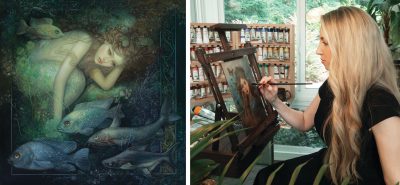
Since we met, Annie and I have worked together on essentially everything. It has been wonderful to live and work with someone who shares my passion and dreams. We often draw and paint in the studio together, and we do often work on images together. Sometimes I will do a drawing or underpainting, and she will paint the final color work, but more often, it’s simply us collaborating on ideas, designs, stories, and helping each other which makes our art the best it can be.
Since becoming a father in recent years, has having children influenced your approach to all the monsters and creatures you concoct?
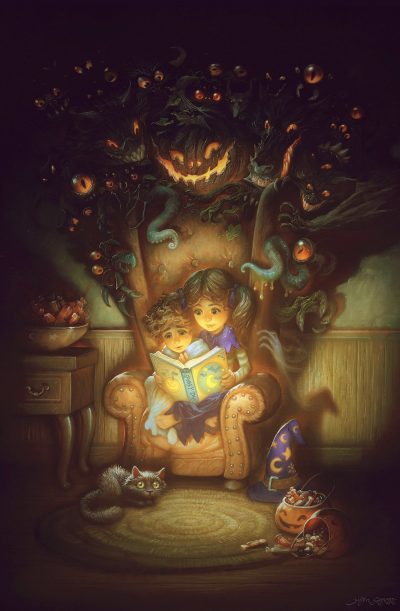 I might be misunderstanding the question, and in my mind have been answering the question of: Do I see my children as little monsters? The answer is yes, hahaha, but also that isn’t bad. I have always loved monsters. I see myself as one, and I kind of see everyone that way. We humans are pretty terrible sometimes, but also capable of pretty amazing things too. I like seeing humans through that lens, and my kids will be no exception.
I might be misunderstanding the question, and in my mind have been answering the question of: Do I see my children as little monsters? The answer is yes, hahaha, but also that isn’t bad. I have always loved monsters. I see myself as one, and I kind of see everyone that way. We humans are pretty terrible sometimes, but also capable of pretty amazing things too. I like seeing humans through that lens, and my kids will be no exception.
But to take the answer further, I think that watching them, interacting with them, and seeing them grow and experience things for the first time has affected my art in other, more meaningful ways. Not in the way of, “oh, I need to now only draw fluffy bunnies and ’safe’ things so that my kids will like my work and my work won’t scare them,” but rather in the way of just wanting to share with others what life is like with kids. The chaos and the fun and the joy and the magic and the mess – all of it. I think the best art comes from life experience, and I think that no matter what, the experience of having them and caring for them will have an indelible effect on my art, whether I mean for it to or not.
What occupies your drafting table right now?
I can’t talk about the major ones because of NDAs, but right now on my desk, let’s see…. I’ve got a lot of sketches of monsters, orcs, and dragons. Amongst the other detritus, there are five empty coffee mugs, a variety of skulls, a set of Kimberly pencils, my vaunted and all-powerful Staedtler 925 on a golden pedestal, an ancient Wacom tablet, a padlocked sketchbook, and a stack of Strathmore Bristol that is ready for action.

A padlocked sketchbook?! Are you worried that at night some art elves might come and steal away your ideas?
I love my younger sisters, but they were always very nosy when I was living at home many moons ago, and they would steal my sketchbooks and look through them, showing them to our parents and friends – that sort of thing. It’s not that I was drawing naked people in there like you might expect, it was that I was very embarrassed of my pitiful abilities back then! I have always had a high expectation of what I wanted to paint, and have pretty much always fallen short of it (especially back then). And so them having my sketches felt like someone having pictures of me from the ‘90s, dressing un-ironically like the Fresh Prince of Bel Aire. (I love Will Smith; Will if you’re reading this, I think you are a legend.) But we can all admit, those photos from the ‘90s have got to go. Nobody wants those circulating on Facebook. Well, my old sketchbooks were like that to me. So I took to being very secretive about them after they were wikileaked to friends and family back when I was a kid.
Also, there are spells in my sketchbook that if read aloud would cause the world to collapse in on itself. I just think it’s best we keep it locked for now.
Thanks for being a part of Illustration West this year, Justin. Might you have any inspiring parting thoughts for the artists who will be entering the competition?
Remember that winning doesn’t matter. Being accepted doesn’t matter. What matters is that by trying to make work worthy of placing in a show like this, you are striving to become a better artist. The GOAL is not the prize, the GOAL is being better than you were last week. Practice every day. You’ll get there.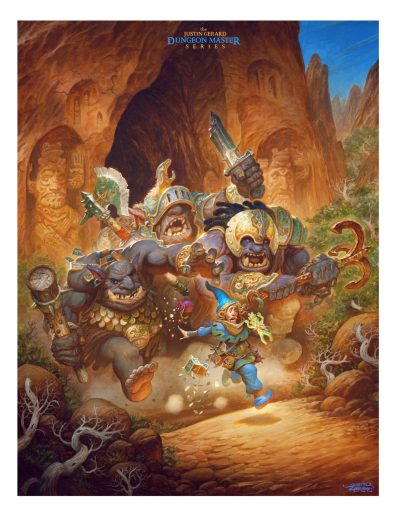
All artwork ©2020 Justin Gerard, not for re-use without
permission of the artist
